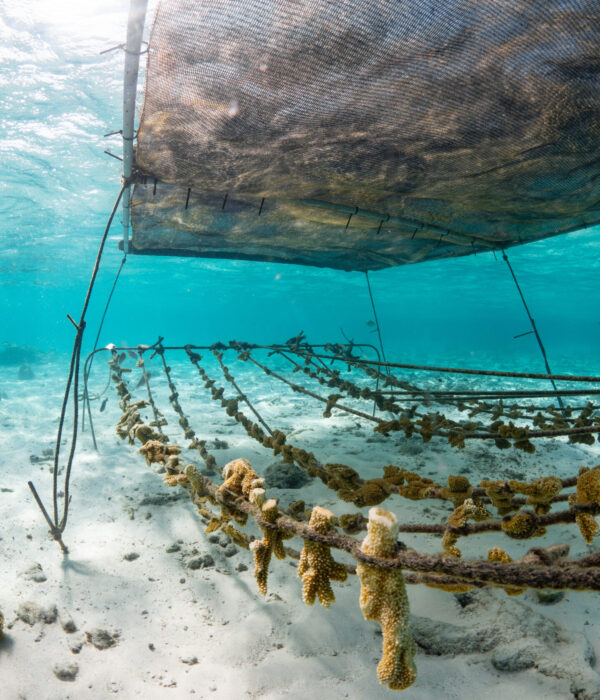By RRFB Intern Nicolas Franchini
This past April, the National Oceanic and Atmospheric Administration (NOAA) released a statement confirming the occurrence of the fourth global coral bleaching event, which persisted from May 2023 through March 2024. At Reef Renewal Foundation Bonaire (RRFB), we witnessed firsthand the devastating impacts of rising ocean temperatures on our coral populations, with significant bleaching occurring in some of our coral genotypes particularly between August 2023 and January 2024.
“Last year, Bonaire’s coral reefs endured one of the most severe bleaching events in recent memory, compounding the devastation caused by stony coral tissue loss disease (SCTLD). At some sites around the island, the reef was reminiscent of snow capped peaks in the Alps,” says RRFB Chief Operating Officer Ernst Noyons.
“Elevated temperatures persisted longer than usual, and, after only a brief period of cooler waters, temperatures began rising again in August. While corals may survive bleaching, their recovery is a long and delicate journey. Ensuring these corals have the time they need to rebuild their strength is crucial for the future health of our reefs.”
Bleaching and Recovery
Coral bleaching, a stress response to elevated water temperatures, can lead to widespread mortality if conditions are too prolonged. Corals are capable of recovering, provided that stressors are reduced and the environment stabilizes. Corals’ resilience and potential to recover depend in part on their unique genetic makeup, with different genotypes – even within the same species – exhibiting varying levels of tolerance to environmental changes.
Some corals, when exposed to low or mid levels of stress- enough to elicit a reaction but not enough to kill them – can actually result in a higher tolerance to future stress events. Hence showing a potential enhancement in their resilience towards subsequent exposures. This environmental memory may prove to be crucial for how corals cope during this time of major environmental change especially considering their susceptibility to such stressors.
Despite roughly 92.5% of the genotypes in our boulder coral nurseries bleaching this past season, we experienced a swift recovery and minimal bleaching mortality suggesting high resilience across our genotypes.
Testing Two Techniques
As Bonaire’s water temperatures begin to rise again in the second half of 2024, we’re preparing for another severe bleaching event. In early July, we launched an experiment aimed at identifying effective strategies to mitigate the effects of bleaching, thereby hoping to reduce mortality due to bleaching for future events.
Based on relevant literature and our own experience, we identified direct sunlight and elevated water temperatures as key factors contributing to coral bleaching. Recognizing the potential of coral shading – an approach successfully implemented by other regional practitioners – we decided to adapt this technique to our nurseries in Bonaire. This led us to pose a critical question: could moving corals to deeper water, shading them, or a combination of both help mitigate bleaching stress?
To explore this question, we designed specialized shading structures to fit our gene bank, boulder and brain coral nurseries, and horizontal rope nursery at Lac Bay. Additionally, we relocated a portion of trees to deeper water, where they’re exposed to lower light levels and cooler temperatures.
Tracking Signs of Stress and Survival
Our experimental design involves two shallow nurseries and two deeper, with one tree from each depth shaded and the other left unshaded. This setup allows us to observe the potential effects of both interventions on coral stress and overall success. This bleaching mitigation, combined with the selective propagation of resilient genotypes, is one of the ways we strengthen vulnerable coral populations.
To track coral condition and overall effectiveness of our approach, we monitor three key indicators of four different genotypes: coral growth, presence of bleaching, and overall survival. Utilizing TagLab software, we analyze photographs of fragments over time to measure growth in square centimeters (cm²). We also conduct in-water observations and collect visual data to assess bleaching and survival rates. In addition, we utilize underwater sensors at each specific tree to collect temperature and light data.

“We’re hoping that this experiment gives us a deeper understanding of how specific genotypes perform and guide our protocol and best practices for future bleaching events. As these events become increasingly frequent and severe, this knowledge will allow us to make better decisions for next year’s challenges and better mitigate future bleaching.”
– Sanne Tuijten, RRFB Monitoring & Data Officer
This ongoing bleaching event, coupled with the imminent threat of future occurrences, has driven us to develop this experiment exploring the effectiveness of coral shading and depth manipulation while also broadening our adaptive restoration strategy. As environmental conditions become increasingly challenging, we must continuously advance our strategies in real time. This means not only refining our techniques and working with a broader range of species but also swiftly implementing new strategies and technologies.
With support from Bloomberg Philanthropies, we implement comprehensive monitoring and mitigation techniques, including coral shading, to safeguard our nursery broodstock and inform our broader restoration strategy.
1. National Oceanic and Atmospheric Administration. (2024, April 15). NOAA confirms 4th global coral bleaching event. NOAA.
2. Hackerott, S., Martell, H. A., & Eirin-Lopez, J. M. (2021, August 5). Coral Environmental Memory: Causes, mechanisms, and consequences for future reefs. Trends in Ecology & Evolution, 36(11), 1011–1023. https://doi.org/10.1016/j.tree.2021.06.014







Awesome work by wonderful people.